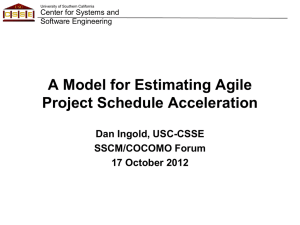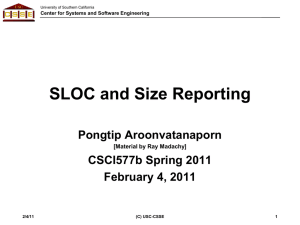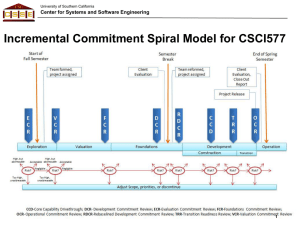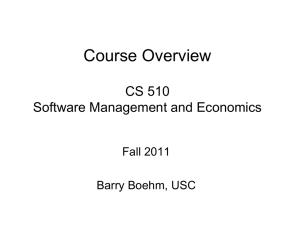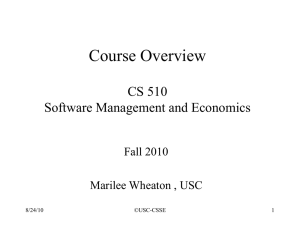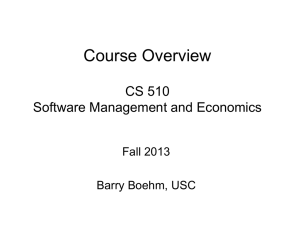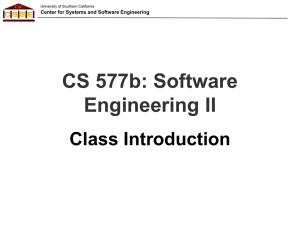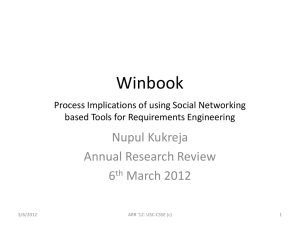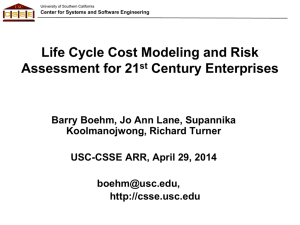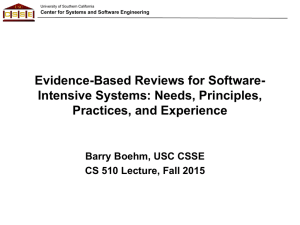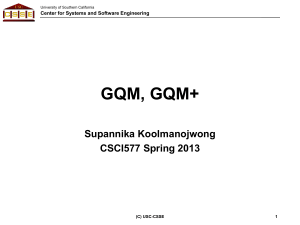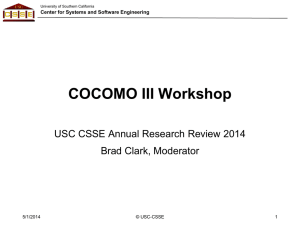EC21_SW_Maintenance - Software Engineering II
advertisement
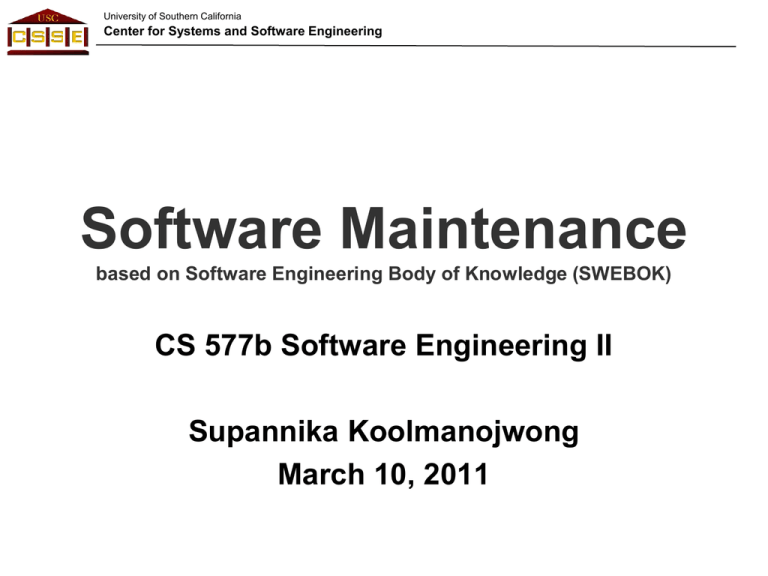
University of Southern California Center for Systems and Software Engineering Software Maintenance based on Software Engineering Body of Knowledge (SWEBOK) CS 577b Software Engineering II Supannika Koolmanojwong March 10, 2011 University of Southern California Center for Systems and Software Engineering Outline • • • • Software Maintenance Fundamentals Key Issues in Software Maintenance Maintenance Process Techniques for Maintenance 03/02/2011 © 2011 USC-CSSE 2 University of Southern California Center for Systems and Software Engineering Definition • IEEE standard [IEEE 1219-98:s3.1.12]: – “the modification of a software product after delivery to correct faults, to improve performance or other attributes , or to adapt the product to a modified environment.” 03/02/2011 © 2011 USC-CSSE 3 University of Southern California Center for Systems and Software Engineering Nature of Maintenance • Sustain the software product throughout its operational life cycle • Modification requests are logged and tracked • Impact of the proposed changed is determined • Code and artifacts are modified • Testing is conducted • New version of software product is released • Need training and daily support 03/02/2011 © 2011 USC-CSSE 4 University of Southern California Center for Systems and Software Engineering 03/02/2011 © 2011 USC-CSSE 5 University of Southern California Center for Systems and Software Engineering Why we need a software maintenance ? • • • • • Correct faults Improve the design Implement enhancements Interface with other systems Adapt programs so that different hardware, software, system features, and telecommunications facilities can be used • Migrate legacy software • Retire software 03/02/2011 © 2011 USC-CSSE 6 University of Southern California Center for Systems and Software Engineering Maintainer’s activities • Maintaining control over the software's day-today functions • Maintaining control over software modification • Perfecting existing functions • Preventing software performance from degrading to unacceptable levels 03/02/2011 © 2011 USC-CSSE 7 University of Southern California Center for Systems and Software Engineering Cost of Software Maintenance • Common perception – software maintenance cost = fixes faults • 80% - non-corrective actions • BUT, many managers put enhancement and correction together 03/02/2011 © 2011 USC-CSSE 8 University of Southern California Center for Systems and Software Engineering Factors influencing maintenance costs • • • • • • Application type Software novelty/uniqueness Software maintenance staff availability Software life span Hardware characteristics Quality of software design, construction, documentation and testing 03/02/2011 © 2011 USC-CSSE 9 University of Southern California Center for Systems and Software Engineering Software Maintenance Categories Correction Enhancement Proactive Preventive Perfective Reactive Corrective Adaptive •Corrective maintenance: Reactive modification of a software product performed after delivery to correct discovered problems •Adaptive maintenance: Modification of a software product performed after delivery to keep a software product usable in a changed or changing environment •Perfective maintenance: Modification of a software product after delivery to improve performance or maintainability •Preventive maintenance: Modification of a software product after delivery to detect and correct latent faults in the software product before they become effective faults 03/02/2011 © 2011 USC-CSSE 10 University of Southern California Center for Systems and Software Engineering Outline • • • • Software Maintenance Fundamentals Key Issues in Software Maintenance Maintenance Process Techniques for Maintenance 03/02/2011 © 2011 USC-CSSE 11 University of Southern California Center for Systems and Software Engineering Key Issues in Software Maintenance • • • • Technical issues Management issues Cost estimation Measures 03/02/2011 © 2011 USC-CSSE 12 University of Southern California Center for Systems and Software Engineering 1) Technical Issues • Limited understanding – 40% to 60% of the maintenance effort is devoted to understanding the software to be modified • Testing – Full testing is costly – Regression testing - retesting of a software or component to verify that the modifications have not caused unintended effects – When to test (possible for offline testing?) 03/02/2011 © 2011 USC-CSSE 13 University of Southern California Center for Systems and Software Engineering 1) Technical Issues • Impact analysis – analysis of the impact of a change in existing software – identify all systems and software products, estimate of the resources needed – Change request; modification request (MR); problem report (PR) – Objectives of Impact Analysis • • • • 03/02/2011 Determine scope of change in order to plan and implement work Develop estimates of resources needed to perform the work Analyze cost/benefits of the requested change Communicate to others of the complexity of a given change © 2011 USC-CSSE 14 University of Southern California Center for Systems and Software Engineering 1) Technical Issues • Maintainability – In order to save cost, determine maintainability during development process, review it and control it – Not emphasized during development process – Mature process helps enhancing maintainability 03/02/2011 © 2011 USC-CSSE 15 University of Southern California Center for Systems and Software Engineering 2. Management Issues • Alignment with organizational objectives – Usually contrast to org objectives: deliver on time, limited budget – Do not show a good number in ROI – No clear quantifiable benefit for the organization • Staffing – Perceived as second-class citizens – Morale therefore suffers 03/02/2011 © 2011 USC-CSSE 16 University of Southern California Center for Systems and Software Engineering 2. Management Issues • Process – Similar to development process, but has unique activities • Organizational aspects of maintenance – Case-by-case policy in task delegation – Dedicated maintainer or a special team • Outsourcing – Usually for less mission-critical systems – Challenges • Scope of maintenance and contractual details • Transition to outsourcer 03/02/2011 © 2011 USC-CSSE 17 University of Southern California Center for Systems and Software Engineering 3. Maintenance Cost Estimation • Cost estimation – Parametric model • COCOMO for maintenance – Experience • Delphi study 03/02/2011 © 2011 USC-CSSE 18 University of Southern California Center for Systems and Software Engineering 4. Software Maintenance Measurement • Common categories – size; effort; schedule; and quality • Based on Maintainability characteristics – Analyzability: Measures of the maintainer's effort or resources expended in trying to diagnose deficiencies or causes of failure, or in identifying parts to be modified – Changeability: Measures of the maintainer's effort associated with implementing a specified modification – Stability: Measures of the unexpected behavior of software, including that encountered during testing – Testability: Measures of the maintainer's and users' effort in trying to test the modified software 03/02/2011 © 2011 USC-CSSE 19 University of Southern California Center for Systems and Software Engineering Outline • • • • Software Maintenance Fundamentals Key Issues in Software Maintenance Maintenance Process Techniques for Maintenance 03/02/2011 © 2011 USC-CSSE 20 University of Southern California Center for Systems and Software Engineering The Incremental Commitment Spiral Model Jan 11, 2011 21 University of Southern California Center for Systems and Software Engineering Software Maintenance Process • Post-delivery stage The IEEE1219-98 Maintenance Process Activities 03/02/2011 © 2011 USC-CSSE 22 University of Southern California Center for Systems and Software Engineering Another Software Maintenance Process ISO/IEC 14764-00 Software Maintenance Process 03/02/2011 © 2011 USC-CSSE 23 University of Southern California Center for Systems and Software Engineering Maintenance Activities • Unique Activity – Transition: a controlled and coordinated sequence of activities during which software is transferred progressively from the developer to the maintainer – Modification Request Acceptance/Rejection: modification request work over a certain size/effort/complexity may be rejected by maintainers and rerouted to a developer – Modification Request and Problem Report Help Desk: an end-user support function that triggers the assessment, prioritization, and costing of modification requests – Impact Analysis – Software Support: help and advice to users concerning a request for information (for example, business rules, validation, data meaning and ad-hoc requests/reports) – Service Level Agreements (SLAs) and specialized (domain-specific) maintenance contracts which are the responsibility of the maintainers • Supporting Activity • Maintenance planning activity 03/02/2011 © 2011 USC-CSSE 24 University of Southern California Center for Systems and Software Engineering Maintenance Activities • Unique Activity • Supporting Activity – – – – – software maintenance planning software configuration management, verification and validation, software quality assurance, reviews, audits user training and maintainer training • Maintenance planning activity 03/02/2011 © 2011 USC-CSSE 25 University of Southern California Center for Systems and Software Engineering Maintenance Activities • Unique Activity • Supporting Activity • Maintenance planning activity – – – – 03/02/2011 Business planning (organizational level) Maintenance planning (transition level) Release/version planning (software level) Individual software change request planning (request level) © 2011 USC-CSSE 26 University of Southern California Center for Systems and Software Engineering Release/version planning activity • Collect the dates of availability of individual requests • Agree with users on the content of subsequent releases/versions • Identify potential conflicts and develop alternatives • Assess the risk of a given release and develop a backout plan in case problems should arise • Inform all the stakeholders 03/02/2011 © 2011 USC-CSSE 27 University of Southern California Center for Systems and Software Engineering Software configuration management • Critical element of the maintenance process • For – verification, validation, – audit of each step required to identify, authorize, implement, and release the software product. • Track Modification Requests or Problem Reports • Control the changes • Different from CM of software development 03/02/2011 © 2011 USC-CSSE 28 University of Southern California Center for Systems and Software Engineering Outline • • • • Software Maintenance Fundamentals Key Issues in Software Maintenance Maintenance Process Techniques for Maintenance 03/02/2011 © 2011 USC-CSSE 29 University of Southern California Center for Systems and Software Engineering Techniques for Maintenance • Program Comprehension – reading and understanding programs in order to implement changes. – Code browsers are key tools for program comprehension. – Need clear and concise documentation 03/02/2011 © 2011 USC-CSSE 30 University of Southern California Center for Systems and Software Engineering Techniques for Maintenance • Reengineering – examination and alteration of software to reconstitute it in a new form, and includes the subsequent implementation of the new form – the most radical (and expensive) form of alteration – It is often not undertaken to improve maintainability, but to replace aging legacy software 03/02/2011 © 2011 USC-CSSE 31 University of Southern California Center for Systems and Software Engineering Techniques for Maintenance • Reverse engineering – Analyzing software to identify the software's components and their interrelationships and to create representations of the software in another form or at higher levels of abstraction – Reverse engineering is passive; – it does not change the software, or result in new software – E.g. redocumentation, design recovery, refactoring (to improve performance), data reverse engineering (logical schemas are recovered from physical databases) 03/02/2011 © 2011 USC-CSSE 32 University of Southern California Center for Systems and Software Engineering Distribution of Maintenance Problem Items 03/02/2011 © 2011 USC-CSSE 33 University of Southern California Center for Systems and Software Engineering 03/02/2011 © 2011 USC-CSSE 34 University of Southern California Center for Systems and Software Engineering References • • [Lientz 1981] Lientz, B.P. & Swanson, E. (1981). "Problems in application software maintenance". Communications of the ACM 24 (11), 763-769. [SWEBOK 2004] Software Engineering Body of Knowledge version 2004 http://www.computer.org/portal/web/swebok 03/02/2011 © 2011 USC-CSSE 35
